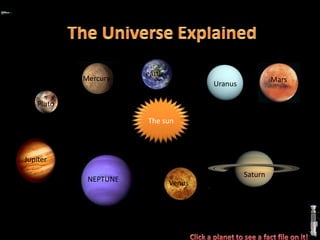The universe explained
•Télécharger en tant que PPTX, PDF•
3 j'aime•1,258 vues
The document provides information about the eight planets in our solar system: Mercury, Venus, Earth, Mars, Jupiter, Saturn, Uranus, and Neptune. It describes key facts about each planet such as their size, composition, orbit, and other distinguishing features. The solar system revolves around our sun, a common yellow star called Sol.
Signaler
Partager
Signaler
Partager

Recommandé
Contenu connexe
Tendances
Tendances (20)
Similaire à The universe explained
Similaire à The universe explained (20)
YEAR 9 GEOGRAPHY - ASTRONOMY: SUN, PLANETS AND GALAXY

YEAR 9 GEOGRAPHY - ASTRONOMY: SUN, PLANETS AND GALAXY
Dernier
Dernier (20)
08448380779 Call Girls In Diplomatic Enclave Women Seeking Men

08448380779 Call Girls In Diplomatic Enclave Women Seeking Men
Boost PC performance: How more available memory can improve productivity

Boost PC performance: How more available memory can improve productivity
What Are The Drone Anti-jamming Systems Technology?

What Are The Drone Anti-jamming Systems Technology?
08448380779 Call Girls In Civil Lines Women Seeking Men

08448380779 Call Girls In Civil Lines Women Seeking Men
Scaling API-first – The story of a global engineering organization

Scaling API-first – The story of a global engineering organization
Axa Assurance Maroc - Insurer Innovation Award 2024

Axa Assurance Maroc - Insurer Innovation Award 2024
Advantages of Hiring UIUX Design Service Providers for Your Business

Advantages of Hiring UIUX Design Service Providers for Your Business
Factors to Consider When Choosing Accounts Payable Services Providers.pptx

Factors to Consider When Choosing Accounts Payable Services Providers.pptx
Understanding Discord NSFW Servers A Guide for Responsible Users.pdf

Understanding Discord NSFW Servers A Guide for Responsible Users.pdf
The Codex of Business Writing Software for Real-World Solutions 2.pptx

The Codex of Business Writing Software for Real-World Solutions 2.pptx
Powerful Google developer tools for immediate impact! (2023-24 C)

Powerful Google developer tools for immediate impact! (2023-24 C)
TrustArc Webinar - Stay Ahead of US State Data Privacy Law Developments

TrustArc Webinar - Stay Ahead of US State Data Privacy Law Developments
The universe explained
- 1. earth Mercury Mars Uranus Pluto The sun Jupiter Saturn NEPTUNE Venus
- 2. Our Sun is not unique in the universe. It is a common middle- sized yellow star which scientists have named Sol, after the ancient Roman name. This is why our system of planets is called the Solar System. There are trillions of other stars in the universe just like it. Many of these stars have their own systems of planets, moons, asteroids, and comets. Did you know! Light from the Sun can reach the Earth in only 8 minutes! This is called the speed of light. The Sun is nearly 93 million miles (approx 145 million km) from Earth.!
- 3. Pluto Pluto orbits beyond the orbit of Neptune (usually). It is much smaller than any of the official planets and now classified as a "dwarf planet". Pluto is smaller than seven of the solar system's moons (the Moon, Io, Europa, Ganymede, Callisto, Titan and Triton).
- 4. Mars Mars is the fourth planet from the Sun in the Solar System. The planet is named after the Roman god of war, Mars. It is often described as the "Red Planet", as the iron oxide prevalent on its surface gives it a reddish appearance
- 5. Neptune Neptune is the eighth and farthest planet from the Sun in the Solar System. Named for the Roman god of the sea, it is the fourth-largest planet by diameter and the third largest by mass.
- 6. Saturn Saturn is the sixth planet from the Sun and the second largest planet in the Solar System, after Jupiter. Saturn is named after the Roman god Saturn, equated to the Greek Cronus (the Titan father of Zeus), the Babylonian Ninurta and the Hindu Shani. Saturn's astronomical symbol represents the Roman god's sickle.
- 7. Uranus Uranus is the seventh planet from the Sun. It has the third- largest planetary radius and fourth-largest planetary mass in the Solar System. It is named after the ancient Greek god Uranus
- 8. Venus Venus is the second planet from the Sun, orbiting it every 224.7 Earth days. The planet is named after Venus, the Roman goddess of love and beauty. After the Moon, it is the brightest natural object in the night sky, bright enough to cast shadows. Venus reaches its maximum brightness shortly before sunrise or shortly after sunset, for which reason it has been known as the Morning Star or Evening Star.
- 9. Jupiter • Jupiter is the fifth planet from the Sun and the largest planet within the Solar System.[13] It is a gas giant with mass one-thousandth that of the Sun but is two and a half times the mass of all the other planets in our Solar System combined. Jupiter is classified as a gas giant along with Saturn, Uranus and Neptune. Together, these four planets are sometimes referred to as the Jovian or outer planets.
- 10. Mercury • Mercury is the smallest planet in the Solar System, orbiting the Sun once every 87.969 Earth days. The orbit of Mercury has the highest eccentricity of all the Solar System planets, and it has the smallest axial tilt. It completes three rotations about its axis for every two orbits. The perihelion of Mercury's orbit processes around the Sun at an excess of 43 arc seconds per century, a phenomenon that was explained in the 20th century by Albert Einstein's General Theory of Relativity.[11] Mercury is bright when viewed from Earth, ranging from −2.3 to 5.7 in apparent magnitude
- 11. Earth Earth (or the Earth) is the third planet from the Sun, and the densest and fifth-largest of the eight planets in the Solar System. It is also the largest of the Solar System's four solid planets. It is sometimes referred to as the World, the Blue Planet,or by its Latin name, Terra